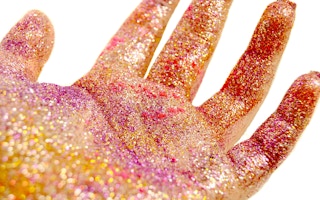Scientists often get a bad rap as party poopers. As a case in point, my colleagues and I have provided data on the impacts of balloon releases on marine wildlife.
So when glitter – a highly visible and easily obtained microplastic – comes under the microscope, you might be tempted to groan. The good news is that we’re not out to ruin the fun: with Mardi Gras around the corner (bringing a ubiquity of sparkling Instagrams), here’s how to find ecologically friendly glitter.
All glitter goes to the ocean
When something fun or common is revealed to be destructive it should be a point of pride in our society that we adjust, adapt and move on to safer alternatives.
It therefore makes sense to investigate what data exist for glitter, and to consider whether it’s time for a change in attitude. So, what is glitter?
Glitter is typically made from polyethylene, the same plastic found in plastic bags and a host of other products. Despite glitter’s popularity in everything from cosmetics and toothpaste to crafts and clothes, remarkably little is known about the distribution or impacts of glitter on our environment. As a scientist, that worries me. Glitter is incorporated into consumer products without any real knowledge of its safety.
In contrast, there are dozens of scientific papers on micro-bead scrubbers (tiny plastic beads), which originate from many of the same products (such as cosmetics and toothpaste).
Research on micro-beads suggests that around 8 trillion beads are released into aquatic habitats every day in the United States alone.
Data for glitter are not available, but given its widespread use the situation is likely to be similarly alarming. It’s far too small for waste treatment facilities to capture, so glitter goes straight into your local river and out into the ocean. Because glitter particles are typically 1 millimetre in size or smaller, they can be ingested by a range of creatures, including mussels.
Again, data on micro-beads can tell us why we should be worried about this: a recent study from Australia showed that toxic chemicals associated with micro-beads can “leach” into the tissues of marine creatures, contaminating their bodies. If mussels, fish and other animals are ingesting glitter and micro-beads, these contaminants likely also pose a risk to humans that consume them.
Thankfully, science is here to help. A range of compostable, vegan, 100% plastic-free “bio-glitters” have been created and are readily available online. So, at your next event, you can celebrate in glorious, sparkly style while also educating passers-by about ocean conservation. (I assure you, this is very popular; I do it all the time and I’m the life of the party.)
“
Fortunately, eco-friendly glitter is becoming much easier to find around the world, and more suppliers are turning to cellulose and other plant-derived bases for their product.
What to look for
Mica, a naturally occurring sparkling mineral, is often offered as a non-plastic alternative to glitter. However, some brands, such as Lush, are now using “synthetic mica” (made in a lab) because mica mining has been associated with child labour, especially in India.
Some plastics labelled “bio-degradable” will only break down in industrial composting units, at temperatures over 50℃. This is very unlikely to happen in the ocean, so look for terms like “compostable” and “organic” instead. (For more information on the difference between bio-degradable, compostable and everything in between, this United Nations report is very comprehensive – just read the summary if you’re in a hurry).
Fortunately, eco-friendly glitter is becoming much easier to find around the world, and more suppliers are turning to cellulose and other plant-derived bases for their product. Wild Glitter‘s founder, like many in the industry, cites “watching a weekend’s worth of plastic glitter wash down the plughole after a festival” as the impetus to sell an “ethical, eco-friendly, cruelty-free way to sparkle”.
Eco Glitter Fun is a member of the Plastics Ocean Foundation, a global non-profit; Glo Tatts makes beautiful temporary glitter tattoos; and, for an Australian twist, Eco Glitter make their product from Eucalyptus cellulose.
Bio-glitter can be incorporated into any product. Tasmanian soap maker Veronica Foale switched to bio-glitter last year and hasn’t looked back – if a small business in a rural area can do it, you can too!
![]() This is the key to success in the battle against litter: not all changes are difficult and affordable alternatives do exist. Once you’ve mastered bio-glitter, embrace the next challenge – a bamboo toothbrush perhaps, or reusable Onya produce bags? Never stop learning. Go forth and sparkle responsibly.
This is the key to success in the battle against litter: not all changes are difficult and affordable alternatives do exist. Once you’ve mastered bio-glitter, embrace the next challenge – a bamboo toothbrush perhaps, or reusable Onya produce bags? Never stop learning. Go forth and sparkle responsibly.
Jennifer Lavers is research Scientist, Institute for Marine and Antarctic Studies, University of Tasmania. This article was originally published on The Conversation.








